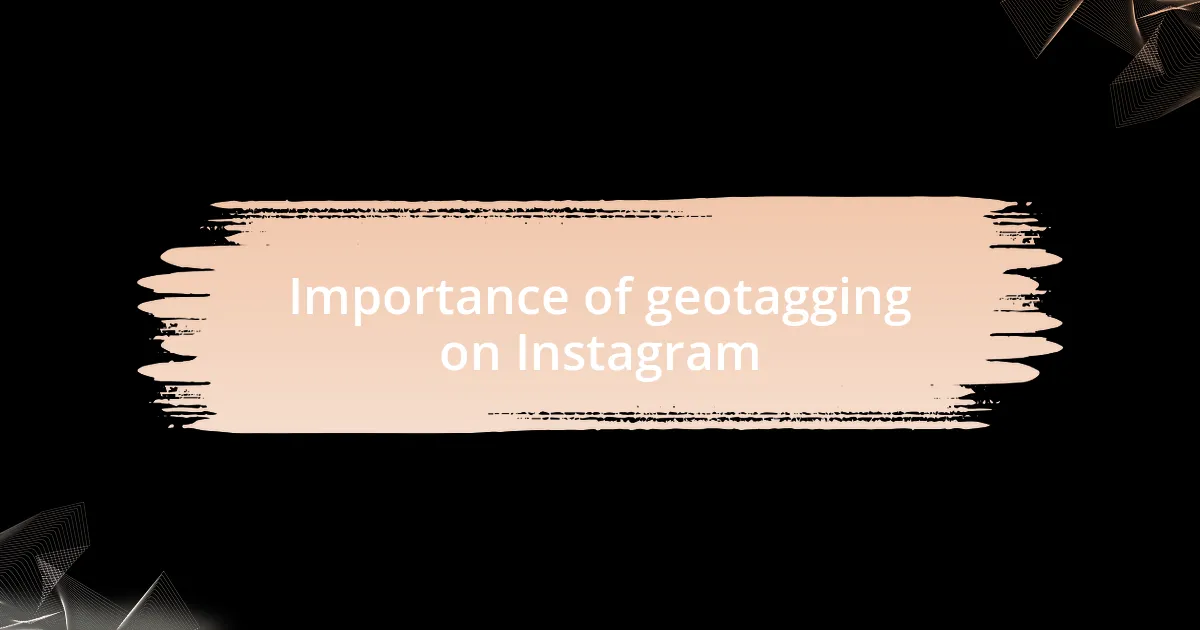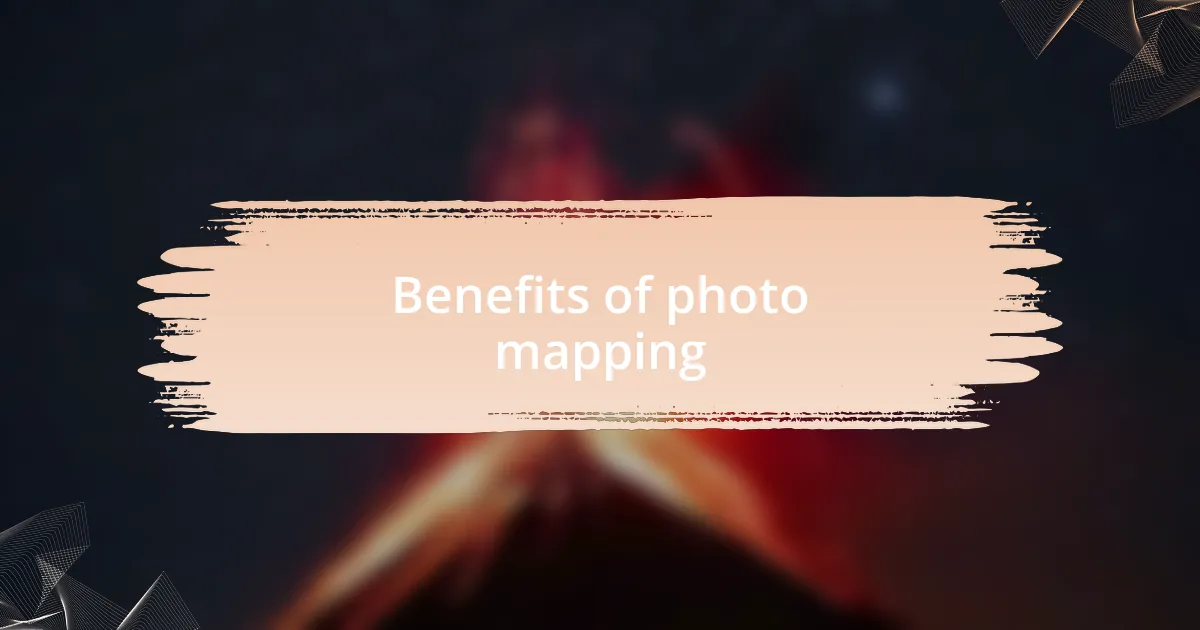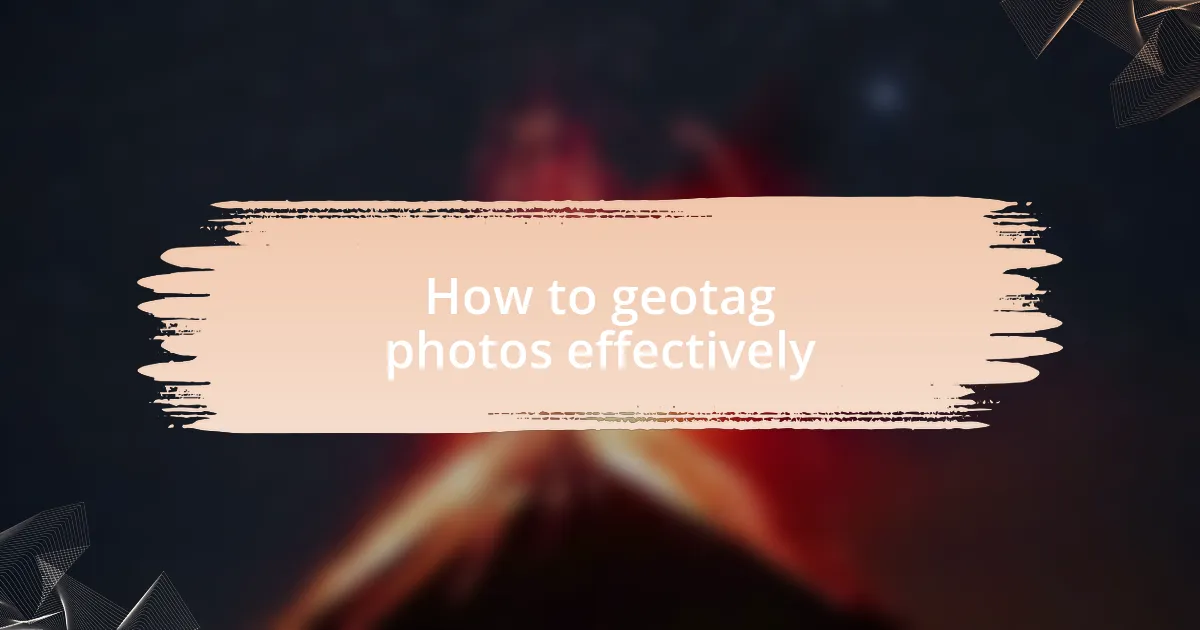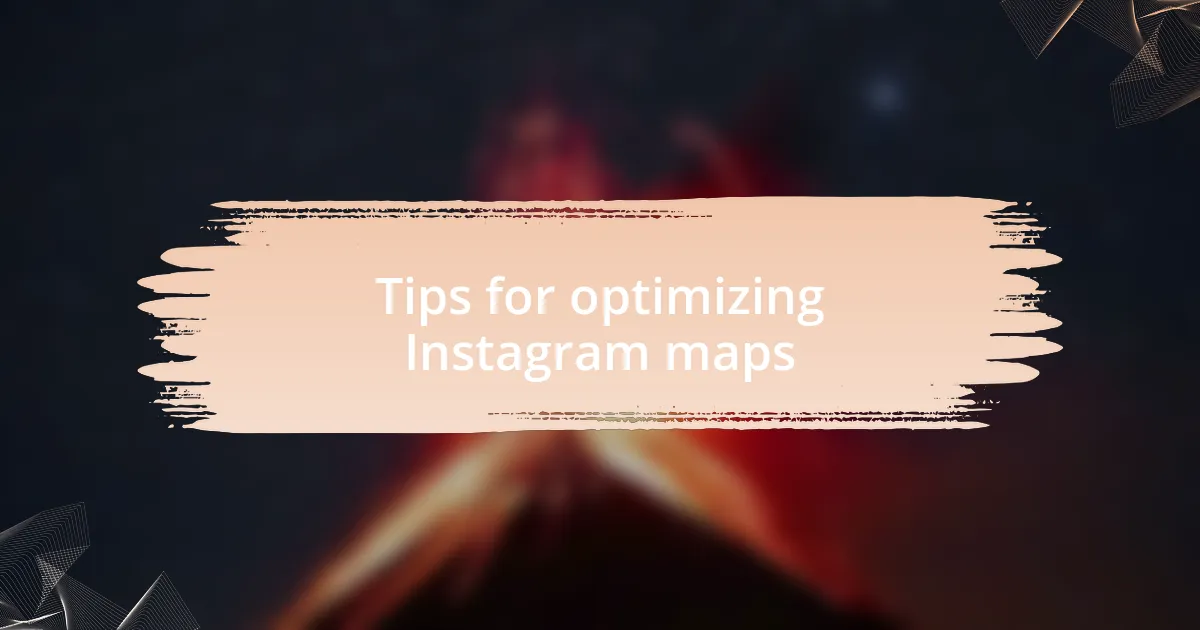Key takeaways:
- Geotagging enhances photo storytelling by embedding location data, allowing viewers to connect memories with real-world places.
- On Instagram, geotagging boosts content discoverability and fosters community engagement through shared experiences.
- Effective geotagging involves specificity, consistency, and engaging descriptions, enriching the viewer’s experience and prompting conversations.
- Timing your posts right after visiting locations amplifies engagement and keeps memories fresh for your audience.

What is geotagging for photos
Geotagging for photos involves embedding geographical information, such as latitude and longitude coordinates, directly into the image file. It’s fascinating how a simple snapshot can turn into a detailed map of your travels! Have you ever looked back at a photo and felt a wave of nostalgia as it reminds you of a specific location? That’s the power of geotagging.
When I first started sharing my photos online, I was amazed to discover that geotagging could connect my memories to real-world locations. Imagine scrolling through your gallery and instantly pinpointing where each moment was captured. I remember feeling a rush of joy when I realized my favorite sunset photo was from that hidden beach I stumbled upon last summer.
In essence, geotagging transforms ordinary images into interactive experiences. It allows you to visualize your journeys and share them with others in a more meaningful way. Doesn’t it make you curious how your own storytelling could evolve by simply tagging your images? Understanding geotagging can truly enhance the way you engage with your photos.

Importance of geotagging on Instagram
Geotagging on Instagram is crucial for building a cohesive narrative around your travels. I recall posting a series of photos from a recent road trip, each with precise location tags. This not only attracted attention but also invited friends to ask about my journey, creating an engaging dialogue that made the memories even more vibrant. Have you ever shared a moment that prompted others to want to know the story behind your photo?
By tagging your images with locations, you significantly enhance discoverability. When users search for specific places, their feeds can showcase your content, pulling in viewers who share your interests. Just last week, I stumbled upon a beautiful café in Paris through a friend’s geotagged post, which led me to incredibly delicious coffee and pastries. Isn’t it amazing how one tagged photo can inspire countless others to explore?
Moreover, geotagging fosters community by connecting people with shared experiences. I’ve often found myself bonding with strangers over our mutual love for a particular location. It’s incredible how simply pinpointing where a photo was taken can resonate with others, leading to discussions and friendships formed over a shared love of adventure. Do you see how geotagging could not only elevate your photography but also expand your social connections on Instagram?

Benefits of photo mapping
Photo mapping offers remarkable benefits for enhancing your online presence. I remember a time when I used geotagging during a family vacation to the mountains. Each photo captured not only the stunning views but also the joy of being together, and with every tag, our memories became easily accessible to friends and family. Isn’t it rewarding to see your most cherished moments neatly organized on a map?
Another major advantage of photo mapping lies in its storytelling potential. Recently, I explored a new city and shared a series of posts, each linked to a different landmark. As I scrolled through my profile later, it felt like a vibrant journey that narrated my exploration. Don’t you agree that seeing a visual path of your adventures adds a rich layer to the experience?
Furthermore, it cultivates a sense of belonging. I once engaged in a discussion with fellow travelers who had visited the same locations I had, all sparked by a few geotagged posts. The ability to connect with others based on shared experiences is truly exhilarating. Have you ever felt that electric connection with someone over a common journey? It’s a beautiful reminder of how geography can unite us.

Tools for geotagging photos
When it comes to geotagging photos, having the right tools can make a world of difference. I often use mapping apps like Google Maps, which allow you to easily mark locations while taking photos. The mere act of pinning a spot enhances the memory of those moments, and I can almost relive the experience each time I return to my tagged photos. Have you ever noticed how much more vivid your memories become when you can visualize them on a map?
There are also specialized photo editing apps like Lightroom and Snapseed that allow you to add location data to your images after capturing them. I remember editing a series of sunset shots from a beach trip, painstakingly ensuring each image got its rightful tag. I found that including these locations not only made the photos more meaningful but also drew more engagement on social media—people love to know where an image was taken!
Another handy tool I’ve found is the Instagram app itself, which has a built-in geotagging feature. I recall tagging a picturesque café in my neighborhood and watching the likes and comments roll in because people were intrigued by the location. Doesn’t it feel wonderful when your photos act as gateways for others to discover new places? That simple tag can turn a beautiful moment into a shared experience for everyone.

How to geotag photos effectively
Geotagging photos effectively isn’t just about adding a location; it’s about telling a story through your images. I recall a day spent hiking in the mountains, where I took the time to tag each breathtaking viewpoint. Later, when I looked back at those images, the geotags brought me back to the crisp mountain air and the laughter shared with friends. Isn’t it amazing how a simple tag can encapsulate an entire adventure?
To optimize your geotags, I recommend being specific about locations. For instance, when I post pictures from my travels, I ensure I use exact names rather than just a city. This practice not only helps my followers find the exact spot but also sparks conversations. Have you ever found yourself browsing through a friend’s photos and suddenly wanting to visit the same café they tagged? That’s the power of precise geotagging.
Additionally, consistency is key. I developed a habit of tagging my photos immediately after capturing them. While taking a road trip, I would pull over, tag the location, and snap a few extra shots. This little routine ensures that I never miss that perfect tag, helping me capture the essence of my experiences. How do you remember to tag your photos? If you make it a part of your photography process, you’ll likely find it becomes second nature.

Tips for optimizing Instagram maps
When it comes to optimizing Instagram maps, paying attention to the descriptions associated with your geotags can make a significant difference. I recall uploading a sunset photo from a hidden beach. Instead of just tagging “California,” I included details like “hidden gem at XYZ Beach.” This not only piqued the interest of my followers but also led to discussions about the beach’s best features. Have you noticed how engaging descriptions can create a sense of adventure in your posts?
Using geotags isn’t just about locations; it’s also an opportunity to connect with your audience. A few months ago, I shared a photo of a charming little café with a geotag and mentioned their signature dessert. The response was overwhelming! People started asking for recommendations, and suddenly, a simple photo sparked a delightful conversation. It made me realize that adding a personal touch to the location can foster interaction. How often do you leverage your geotags to spark engagement with your audience?
Lastly, consider the timing of your posts. I’ve found that sharing a photo right after visiting a location helps keep the memories fresh, which resonates in the comments I receive. There’s an urgency in sharing experiences while they are still vivid in your mind, like the time I posted about a vibrant festival just as it was happening. The energy of that moment was palpable in my captions. Have you ever thought about how timing can amplify the effectiveness of your geotags?

My experience with photo geotagging
My experience with photo geotagging has shaped how I view and engage with the locations I visit. I remember a trip to an art gallery in a bustling city where I tagged my photos not only with the gallery’s name but also included the artists’ stories. This personal touch resonated deeply with my followers—they appreciated not just the visual but the context behind what they were seeing. Isn’t it fascinating how a little more effort can turn a simple tag into a memorable experience for someone else?
On another occasion, I decided to geotag a local park during the cherry blossom season. The delicate pink blooms provided a stunning backdrop, and I went beyond just tagging the park’s name. I shared a quick anecdote about my childhood picnics there, which brought others to share their own memories. It was a reminder of the emotional connections we create through shared places. Have you ever considered how your own stories can transform a location into something more meaningful?
Timing is everything, as I quickly discovered. After attending a weekend farmer’s market, I posted a series of photos right as I was leaving, tagging the local vendors. I included a note about my favorite finds from that day’s market. The response was instant, with many followers asking for more details, and I realized then how sharing moments in-the-moment can ignite excitement. Have you thought about how seizing the right time to geotag can turn your followers’ curiosity into conversation?